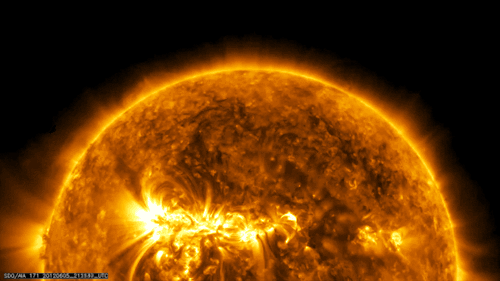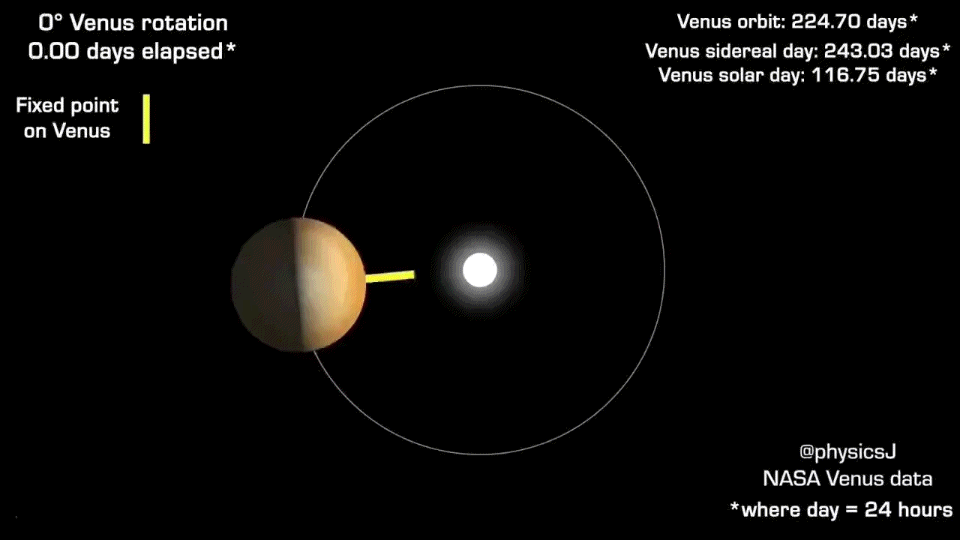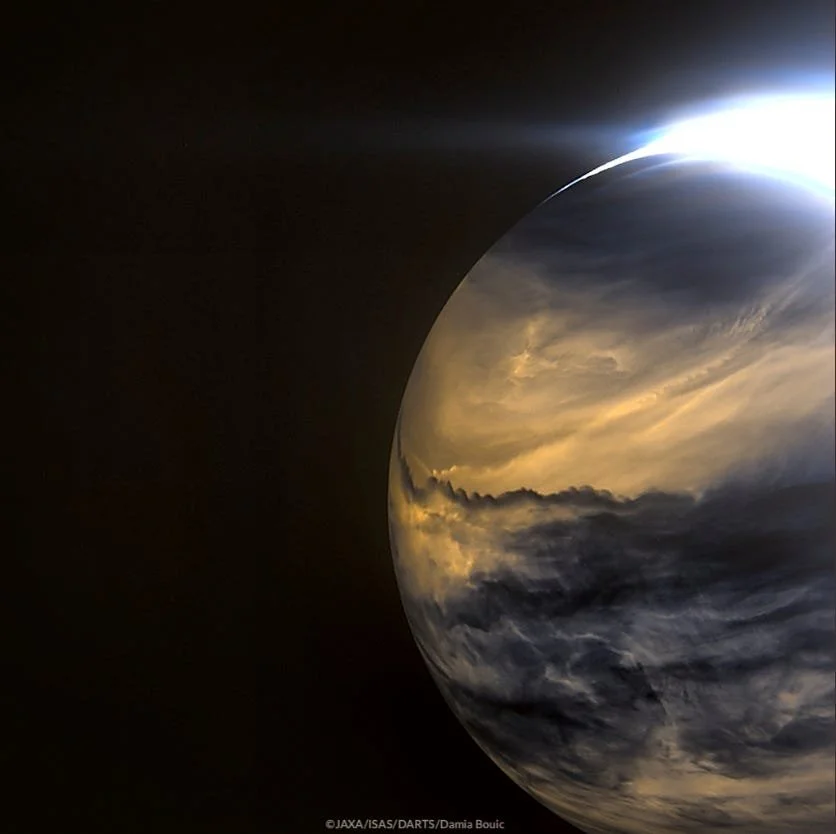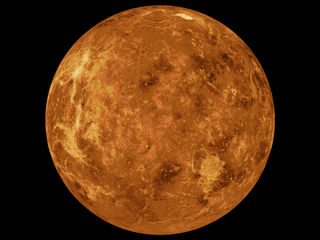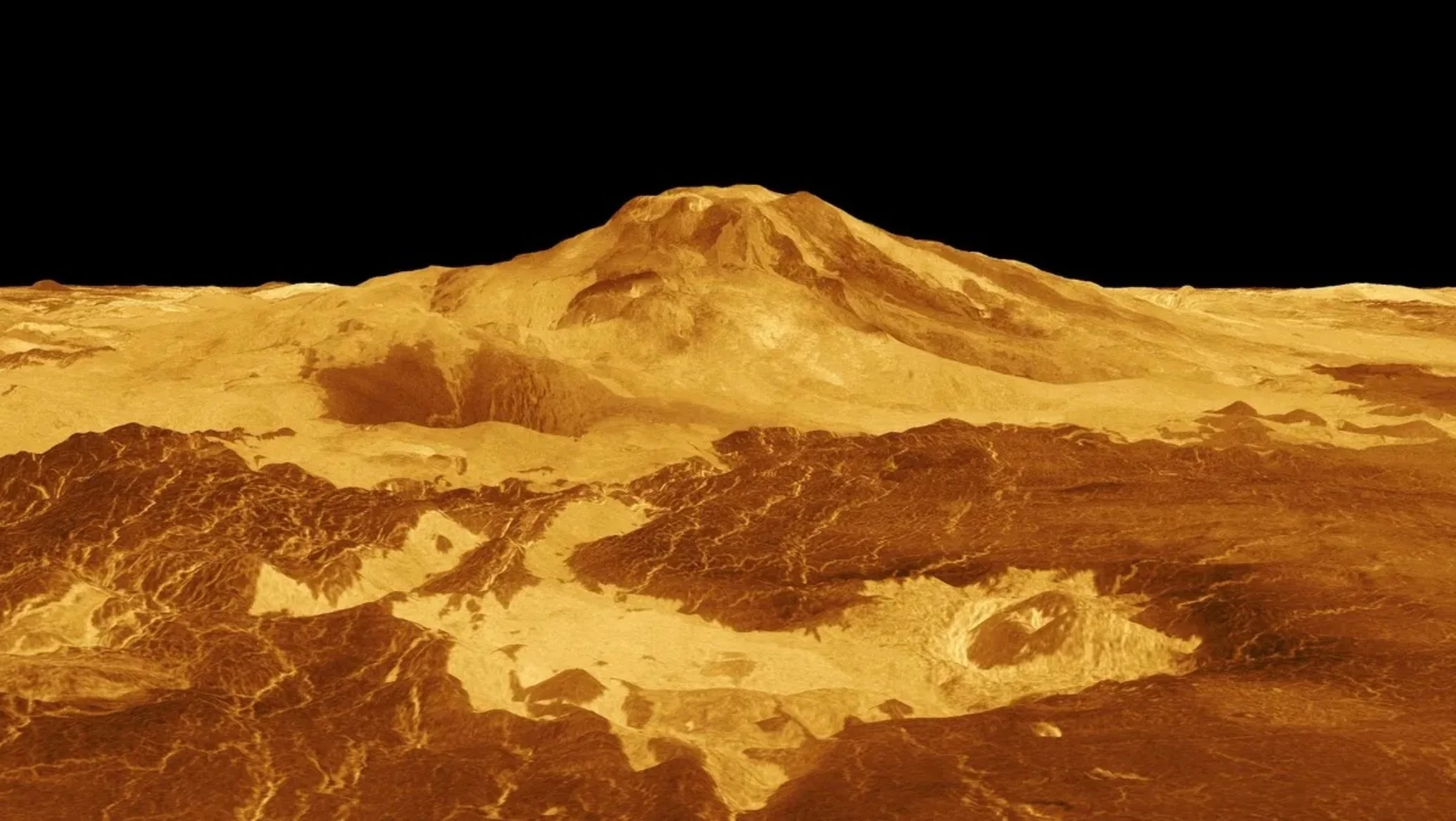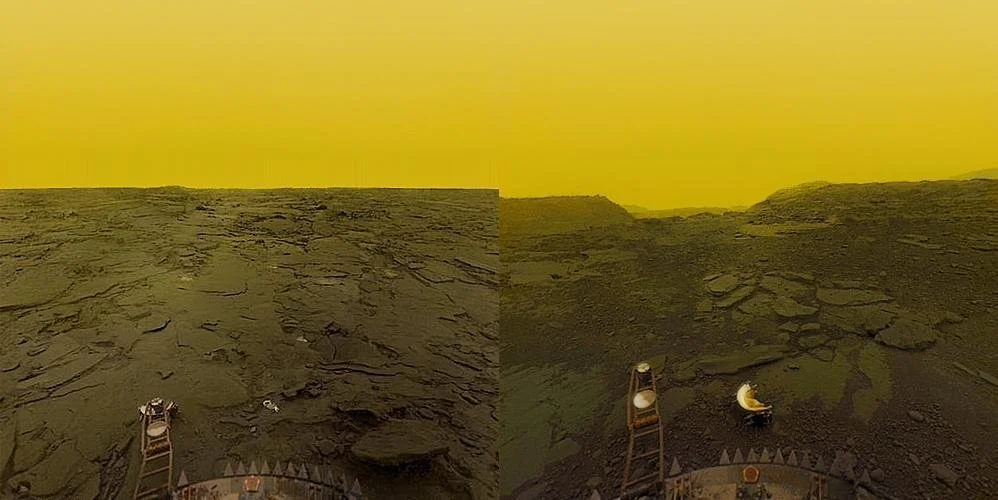VENUS
Earth’s lead-melting twin sister.
Distance from the Sun: 108 million km (0.7 AU)
Diameter: 12,100 km
Rotation period: 243 days
Orbital period: 224 days
Venus is quite similar to Earth in its size, mass, density and composition. It is only 5% smaller in diameter and both planets have a layered structure, with cores composed primarily of iron and nickel surrounded by rocky mantles rich in silicates and other minerals, with thin crusts on their exteriors. Venus is also the closest planet to Earth with an orbit only 0.3 AU away (an astronomical unit equals the distance between Earth and Sun). All these things suggest Venus and Earth formed around the same time and from the same building blocks. These are, however, where the similarities end.
Like Mercury, the orbit of Venus is inferior to Earth’s, meaning it is closer to the Sun so we can only really see it from Earth’s surface during sunrise and sunset as it is otherwise below the horizon or washed out by sunlight. As Venus orbits around the Sun, we can see different sides of it cast in shadow as the angle of the sunlight changes, just like we see with the phases of the Moon as it orbits Earth. Some key differences are that as Venus gets closer to being “new” it gets closer to us and its angular diameter gets bigger and we pretty much never get to see it “full” from Earth as this is when it is on the furthest side of the Sun.
Also like Mercury, it occasionally transits the Sun, though it is much more rare. They happen in a repeating cycle starting with a pair of transits eight years apart, then a long gap of 121.5 years, followed by another eight years and then 105.5 years. If you were hoping to see one of these with your own eyes you unfortunately have a long wait ahead of you. The last two transits took place in 2004 and 2012 so we are early into one of the long intervals. The next transits of Venus will occur in 2117 and 2125.
Note: Never look directly at the Sun without approved solar glasses or a solar telescope filter. Otherwise, you could risk permanent eye damage and/or blindness.
The rotation of Venus is even more peculiar than that of Mercury because it rotates clockwise. Other planets in the solar system rotate counterclockwise which means Venus more or less rotates backwards and it rotates very slowly. So slow, in fact, that a solar day on Venus lasts over half of its year and a sidereal day on Venus lasts longer than its whole year. If you were to stand on the surface of Venus, the Sun would rise in the west, travel across the cloudy, opaque sky for four months, then set in the east followed by four months of pitch-black darkness.
Fun fact: Because of the “right-hand rule,” scientists consider the north pole of a planet to be whichever side the planet appears to rotate counterclockwise from. Therefore, Venus is technically considered upside down.
Fun fact: The only other planet in the solar system with such a bizarre axial tilt would be Uranus which is tilted on its side.
Venus has an incredibly thick and toxic atmosphere. It is almost entirely made up of carbon dioxide which traps heat from the Sun really well and has created a runaway greenhouse effect on the planet. Temperatures can get as high as 900°F, hot enough to melt lead. Despite being the second closest planet from the Sun, this makes Venus the hottest planet in the solar system. Even hotter than Mercury. The atmosphere also features opaque and highly reflective clouds of sulfuric acid, giving Venus the highest albedo in the solar system. It is the third brightest object in Earth’s sky. The atmospheric pressure at the surface of Venus is 92 times that of Earth at sea-level. This is equal to the pressure about 1 km below the Earth’s ocean surface. To stand on the surface would mean enduring 1,350 lbs. of pressure crushing down on every square inch of your body.
The cloud tops of Venus are stricken with strong, perpetual winds that blow westward, parallel to the equator. They can reach speeds that are 60 times faster than the planet’s rotation, circling the planet in only four Earth days. This is called a super-rotation. However, wind at the surface is a gentle breeze to non-existent, obstructed by the thick and heavy atmosphere. Winds are stronger at the equator and slow towards the poles, creating a “V” pattern seen in images of the cloud layers.
While carbon dioxide keeps heat trapped within the atmosphere, Venus’ powerful winds help distribute the scorching air around the planet, keeping the night side almost as hot as the day side. Also, the heated air moves upward in the atmosphere via convection, it produces infrared radiation. This has been observed using infrared telescopes such as Japan’s Akatsuki space probe.
The thick atmosphere of Venus makes optical observation of the surface impossible from both Earth-based or orbital vantage points. Fortunately, probes like the Magellan spacecraft (1989-1994) have been able to use various forms of radar to cut through the opaque clouds and map the surface. Radar uses pulses of electromagnetic waves that reflect off distant objects, return back to the source and record the time it took which reveals how far away the target object is.
Radar mapping reveals numerous geological features like volcanoes, mountain ranges, great chasmic rifts, impact craters and wind erosion. The Venusian surface is dry and rocky with 80% of it covered by rolling plains, and much of it characterized by broad, gently-sloping lowlands that can stretch thousands of kilometers across. Visible flow patterns on these plains indicate volcanic lava flows as the origin while dunes and yardangs indicate strong wind erosion and wind deposits. Contrasted against the plains are three massive continent-sized regions of mountainous highlands:
Aphrodite Terra along the equator (roughly the size of South America) which is characterized by ridges, deep rift valleys and mountain ranges.
Ishtar Terra in the northern hemisphere (roughly the size of Australia) which is characterized by a high, flat plateau bounded on most sides by the planet’s four main mountain ranges.
Lada Terra at the southern pole is characterized by an oval-shaped bulge called a corona surrounded by volcanic rifts and plains.
Venus is dominated by volcanic features with the most volcanoes of any planet in the solar system (over 80,000). Volcanism is believed to have played a major role in shaping the surface via lava flows. In fact, Venus may have undergone a mass global resurfacing event about 500 million years ago. Observation of Magellan space probe images have confirmed that Venus remains volcanically active to this day.
The surface and atmosphere of Venus together create a nightmarish environment and render unmanned-exploration incredibly difficult and manned-exploration improbable. However, humans have managed to put probes in orbit around Venus and landers on the surface. On October 8, 1967, the Soviet Union successfully landed the first man-made object on another planet. The Venera 4 probe arrived at the planet via a fly-by spacecraft which dropped the lander. After parachuting to the surface, the lander analyzed the Venusian atmosphere’s composition, temperature and pressure, then relayed the data up to the fly-by spacecraft which in-turn relayed it back to Earth. It lasted about 23 minutes before succumbing to the hostile elements.
Fun fact: During entry, the temperature of the Venera 4 lander’s heat shield rose to almost 20,000°F.
In total, only four spacecraft have ever returned images of the planet’s surface. These Soviet probes were only able to withstand Venus’ scorched, crushing atmosphere for a matter of minutes to a few hours before being destroyed.



